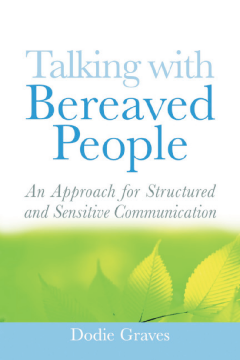
Additional Information
Book Details
Abstract
It can be hard to know what to talk about with a bereaved person over a period of time once you have offered your condolences. This book shows how, by using good active listening skills, empathic exploration and a willingness to talk about the hard issues, you can embark on a process of sensitive conversation that helps the bereaved person to come to terms with their grief.
Dodie Graves outlines a practical framework of six elements for conversing with bereaved people in a structured but flexible way that avoids prescriptive instructions. The elements include talking about the story of the deceased, their relationship with the person, celebrating their life, discussing their legacy, strategies for coping and thinking about the journey undertaken. She shows how to use the elements in conversations with individuals and groups, and for each element suggests creative activities and open questions that can be used, provides anecdotes and case vignettes, and gives a brief summary of the theory pertinent to each stage of the conversation.
Talking with Bereaved People is an approachable tool for anyone working with bereaved people, including counsellors, voluntary bereavement agencies, church pastoral teams, hospice and hospital staff, trainers and social workers.
Dodie Graves has over 15 years' experience as a counsellor. She is currently a bereavement service co-ordinator for a hospice in the West Midlands, recruiting, training and supervising a team of voluntary bereavement visitors in active listening skills and bereavement issues.
This book is like all the best things in life: Common sense mixed with insight and experience. It is backed with the theories necessary for every academic subject that in my opinion – in bereavement work – should be read, ingested and put to the back of our minds to be drawn upon when needed, but not at the expense of experience.
Dodie Graves has made “Talking with bereaved people” look an easy work, but that is because she has the expertise needed to make it look that way…she has used her wide knowledge of the field, experience of bereaved people, excellent listening skills and sensitivity, along with the intelligence to know how much of each ingredient needs to go into the mix.
This book is suitable for people working in the bereavement support field on a good many levels. For new volunteers it is accessible, easy to understand and the use of case studies and personal anecdotes brings it to life. On the other hand, qualified counsellors with experience of general work, perhaps in doctors' surgeries or counselling agencies, would find so much to help them understand what makes bereaved people think and behave as they do. It will also reassure those who are unused to the vast differences in reactions to grief that there are very few occasions when a bereaved person's emotional or physical behaviour can seriously be called unusual or complicated. Given time, patience and a good listener, most people have the inbuilt resilience to work their way through their grief. Dodie encourages this and shows how, with her help, we could all walk beside bereaved people on their journey.
Diana Rivers, independent counsellor, supervisor and consultant trainer for bereavement services
I found this book to be very appropriate for me in my role as a counsellor coordinating a hospice-based bereavement support service, and also as a trainer and supervisor of volunteers.
It was very easy to read and digest, and I particularly like the style of writing. I really felt I was with the author having a conversation – I felt included, and questions I had seemed to be pre-empted and explained or clarified the further I read. The dialogue was punctuated with personal and volunteers' experiences, which allowed for further explanation of the points being talked about.
The invitations to the reader to do an activity or reflection were natural and I felt I wanted to do them, not that I should do them- this element I think will be most helpful for volunteers. The six dimensions, again are simple, clearly explained and easy to understand and carry out, I think even a bereaved person reading this book would find it helpful or useful in their journey. Explanations of core models and theories are easy to read and understand for all levels of reader.
An excellent book which prompts development of existing knowledge whilst encouraging and inspiring new volunteers in their conversations with bereaved people.
Jane Murray, Bereavement Co-ordinator, Marie Curie Hospice, Solihull, Birmingham
